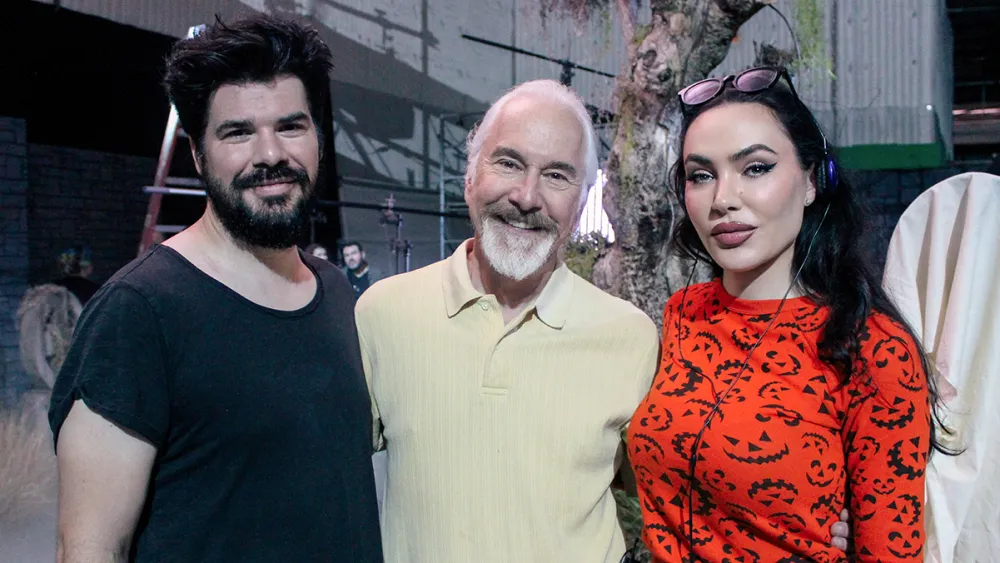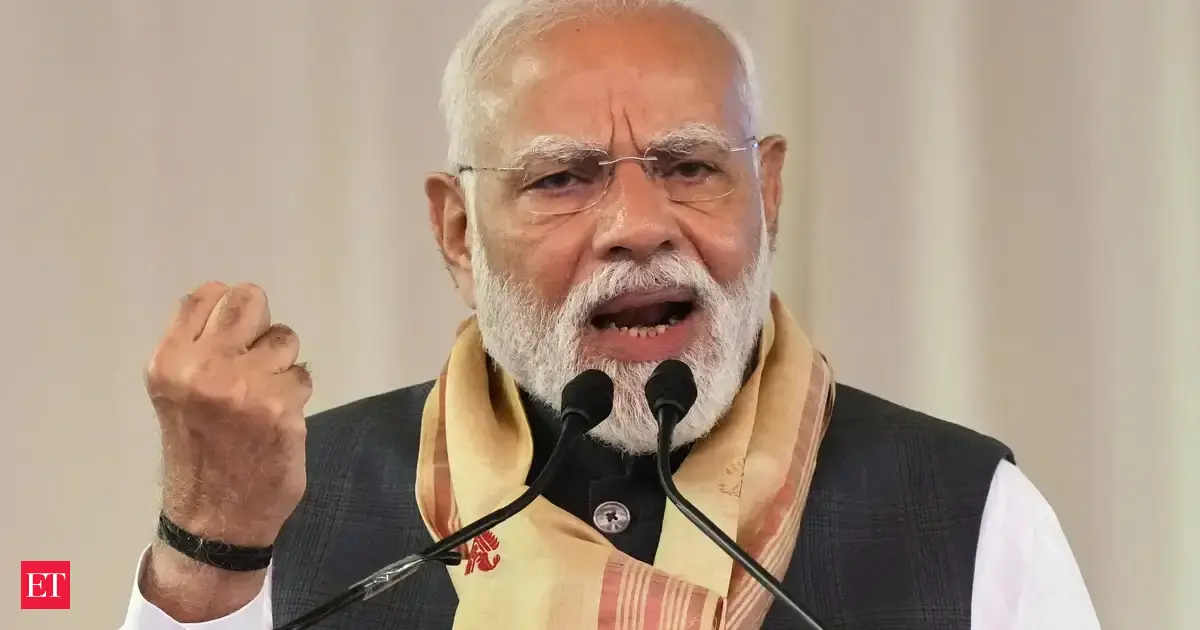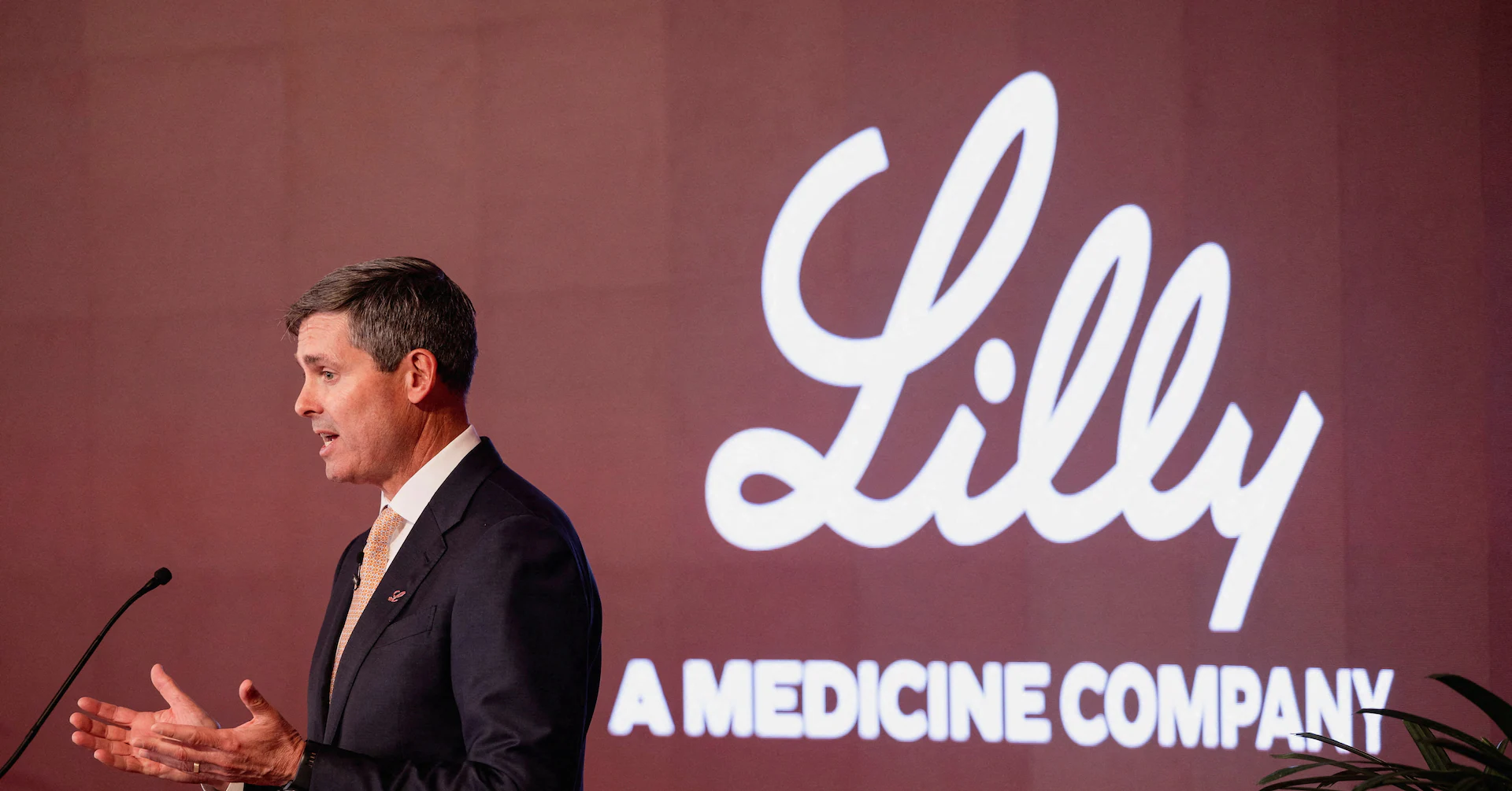
There are few figures in movie history that have become more synonymous with their craft than Rick Baker. He won the inaugural Academy Award for makeup in 1982 for “An American Werewolf in London” — the first of eight wins over his five-decade career. He designed Mos Eisely’s barfly scum for “Star Wars,” created dozens of Gremlins for “The New Batch” and covered Jim Carrey in green fur for “How the Grinch Stole Christmas” before retiring in 2010. But for someone who has created some of the most memorable transformations ever put to screen, Baker has a somewhat surprising genre aversion.
“I’ve done gore, but I’m not actually a real big slasher-hound,” he says. “People don’t believe this, but I’m squeamish. If I cut myself, I pass out.”
Nonetheless, Baker consented to getting his head liquified for his friends R.H. Norman and Micheline Pitt-Norman. The married directing duo put the behind-the-scenes craftsman in front of the camera for their segment of “V/H/S/Halloween,” the eighth installment in the found footage anthology series, playing Beyond Fest on Sunday before debuting on Shudder on Oct. 3.
For the uninitiated, “V/H/S” has become an annual enterprise for horror fans. Every entry is composed of a handful of found-footage short films, with each helmed by a different director. Modern genre staples like Ti West, Timo Tjahjanto and the “Scream” revival team Radio Silence have all tapped into the series over the years.
The Normans are the latest in that tradition, joining “V/H/S” while prepping production on their debut feature “Cosmetic” at Atomic Monster. Their segment, “Home Haunt,” is the final chapter of “V/H/S/Halloween.” It sends audiences off with a premise that bloodies up the ’80s Amblin aesthetic: a suburban haunted house pop-up, run by an overeager father whose son has outgrown the holiday spirit, inadvertently transports trick-or-treaters to a murderous alternate reality.
“When we got asked to put up some ideas for ‘V/H/S,’ one was inspired by Rick’s family and other Burbank families doing their home haunts,” Pitt-Norman tells Variety. “We told Rick about it and how he inspired it. And he’s like, ‘You gotta put me in it.’ We took it literally.”
“Oh, you’re blaming me for this,” Baker says with a chuckle. “That’s not the way I remember it.”
The pair are meeting me mid-June, inside an office perched on the second-floor of Zio Studios in Burbank. Pitt-Norman first met Baker as a fan, but a friendship took after he reached out asking her to model as the Bride of Frankenstein for his Mac cosmetics campaign. Upon Baker and Pitt-Norman’s reunion, I quickly become a bit of a third wheel. Pitt-Norman hails Baker as “the best girl dad,” having come from a pilates session with his family. Baker remarks how “Home Haunt” recruited his “old foam guy” for the effects team.
Baker is just stopping by the set, having already shot his role in the L.A. suburb of Pomona. Today, the directors are capturing some of the short’s biggest scares. Pitt-Norman pauses the conversation to watch a video feed of a musty bog set on the floor below. Her husband is directing a screaming grade-school-aged girl who is about to have a prosthetic finger bitten off. It’s the first of two child deaths on the day’s schedule.
“It’s the first time a green witch has ever eaten children on camera. And the first green witch in an R-rated movie,” Pitt-Norman says, carefully recounting the exact milestones. “The producers were like, ‘We need it to be scarier. It’s too “Goosebumps.”’ And I’m like, ‘Well, I guess we’re going to kill kids then.’”
Baker’s character gets his own memorable sendoff in the movie, though Pitt-Norman says he wasn’t on-screen for the kill shot. With all that gushing blood, they wanted to “make it easy for him.” In an amusing touch for viewers who can recognize Baker and know his craft, his character is a grump who has nothing but criticism for the Halloween décor. Each of his lines comes as some permutation of, “This looks like shit!”
“I was scared that Rick was going to be like, ‘I don’t want to fucking do this.’ But he’s such a good actor,” Pitt-Norman says. “He knows when the camera is on him and when he needs to do something subtle. He hit all his marks, but one.”
“I totally missed my cue,” Baker says, shaking his head. “I was looking at the stuff and wasn’t really paying attention.”
Baker’s eyes continue to wander during this conversation too. At one point, he asks Pitt-Norman to explain an upcoming camera move. Later, he wants to know how one actor handled their death scene. “Home Haunt” is a breakneck enterprise: a five-day production on a tight budget, shooting just three months before “V/H/S/Halloween” debuts at genre festivals in the fall. It’s a pace that seems to invigorate Baker, even though he’s been formally retired for over a decade.
“Being around everybody yesterday, it was like what I thought working on a film was like when I was a kid,” Baker says. “Everybody just wanted to be there and do whatever to help. I was so shocked when I got into the real business.”
That admiration goes both ways too. Baker is a VIP on “Home Haunt” even before he gets to set. Three different people ask if the air-conditioning is running ahead of his arrival. The 74-year-old is no diva, but they want to make sure he’s comfortable.
“He was in the makeup department the whole time,” Pitt-Norman recalls about his time between shots.
“I almost wanted to jump in and give your executioner guy a hand,” Baker says. “But then I also thought it would just make him nervous.”
“I actually think you would have created a life memory that they probably would have cried about out of joy later on,” Pitt-Norman answers.
“Usually when someone goes, ‘I’m a big fan, would you sign a poster?,’ I go, ‘You were 10 when you saw this movie,’” Baker says. “Like my wife said, ‘Well you liked all these shitty movies that you saw when you’re a kid, so don’t burst this kid’s bubble!’”
As the production breaks for lunch, Norman enters the room to tell Baker, “Our witch wants to meet you.” Following Baker downstairs to the make-up department, he immediately greets the actress and the team touching up her green skin. Baker inquires about the design of the hunchback and hovers his hand above her bulbous boils. Though his days doing make-up for the movies are long over, it’s clear he can’t help but get a little involved.
Beforehand, Baker gave a solo interview. Read the conversation below.
Are there any especially challenging jobs that still linger in your mind?
Things that’d never been done before, like “American Werewolf.” When I did John Landis’ first film “Schlock” at 20, he told me, “I really want to show the pain and I want the werewolf to be able to move.” I go, “I’d love to be able to figure it out, but it’s going to take more time and more money than what you gave me on this one.” Because John’s a really smart filmmaker and knows his business, he just let me do my thing. He wanted it really brightly lit, which I wasn’t that crazy about. It’s nice to have shadows to hide things. But he goes, “I can get rid of half the crew. If this shot takes 10 hours, you could take 10 hours.” I’ve done a lot of interviews that ask, “What was the new material that allowed you to do this?” I say, “Adequate time and adequate money.” I mean on “Gremlins 2: The New Batch”—
Which I understand you had to be somewhat coaxed into coming aboard for.
I turned “Gremlins” down a lot. First of all, the first one practically killed my friend, Chris Walas, so I didn’t want to die. And his designs were already done. But Joe Dante had a suggestion box of what the Gremlins should do and I asked to redesign the characters. We had to make an army of puppets, but it was a lot more fun. When I drove to my shop one morning when I was trying to decide, there was a “For Lease” sign on the building next door. It was like a sign from God — I can expand my shop to the next door. So I’m glad I did it. And we made a shitload of stuff.
It was definitely worth it. Everyone has five different favorite Gremlins in “Gremlins 2.”
I knew Joe was a Chuck Jones guy. We grew up watching the same movies and we had a shorthand we could use. Now, working with somebody like Barry Sonnenfeld on “Men in Black,” he goes, “I’ve never even seen a science-fiction movie.” And I thought, “Okay, well, this could either be really bad or really good.” But Barry made the right decisions. Tommy Lee Jones, at times, tried to be funny. Barry said, “No, it’s funnier if you’re not funny.” I did those horrible Joel Schumacher “Batman” movies and designed the Two-Face makeup for Tommy. I thought, “Oh, he’ll be cool,” but he was trying to compete with Jim Carrey.
I like how candid you are about if you think a movie you worked on isn’t very good.
Most movies I worked on weren’t very good actually, you know? (Laughs) I am amazed that movies ever even get finished — let alone be good. It’s a miracle. I mean, my very first film called “Octaman” — I don’t know if you know about that.
I don’t.
Oh, you’ve got to watch it. It’s horrible. It was shot in 10 days. I had six weeks and $2,000 to make a full-body rubber octopus suit while I was finishing my second year of college. I asked to redesign the Octaman and they said, “Kid, there’s only going to be one shot where we see the whole Octaman.” We lost a day because of an accident, when a guy throws a log at the Octaman and he knocks it away and he’s supposed to pick up Pier Angeli. Talking to the director, I go, “We’re gonna rehearse this, right?” He goes, “No, we don’t have time.” Action! He breaks out the door, he knocks a guy down on the ground. A guy throws this tree limb. He knocks that to the guy on the ground and it breaks his hand. The tree limb wrecks my suit. And the Octaman can only look through his two little holes. Then he steps on this guy’s nuts and falls over backwards, throwing Pier Angeli up against a Winnebago. The director was tearing pages out of the script. “We don’t need this. We don’t need this.” There’s like a half-hour of stock footage in the movie instead.
You’ve been open about how your retirement was prompted by being offered less resources and facing more uphill battles in a post-CGI industry. Was there a particular moment you remember that balance starting to shift?
I remember when “T2” came out. Instantly, we were dinosaurs. I embrace the new technology personally. It’s another way to do stuff that we can’t do. But at the time I went, “10 years from now, you’re going to look back at this stuff and it’s not going to look that amazing.” And that was true. You look at a ’90s CG monster — it’s crap. You look at “Harry and the Hendersons,” it still adds up. My problem was always getting a decision early on. Like on “Gremlins 2,” I started a year before production. But a lot of directors wait until the very last minute. That’s what made me jealous about the computer stuff: they could just tinker.
That makes me think of the industrywide concern around AI, and how it could kill jobs or entire crafts.
It’s going to take a lot of jobs. I’ve seen some cool stuff that was done with AI. But it’s going to get to the point where it’s so homogenized; everything is going to look exactly the same. They’re going to want an artist again. It’s the same thing when they were doing computer aging. There’s a real difference with an actor looking in a mirror and the face looking back at him isn’t his. Again, I like that there’s technology that can do stuff. But something I said from the beginning was, “Just because now you can have 40 werewolves climbing up the walls, doesn’t mean that you should.”
What’s a part of your job that you could only do with ample time?
I’d do tests on myself. On “Grinch,” I couldn’t breathe out of the nose, so I added these whiskers and a little Vac-u-form that went to those. I’ve had my whole body cast. I’ve had my eyeballs cast! I like to know what it’s like on the other side. My dad helped me do my first life mask with a plaster mold. We knew enough to put Vaseline on my face, but it got really, really hot. We pulled this thing off and half my eyebrows were gone.
You’re still retired from movie make-up for good then?
I did a couple of scar designs for “Mortal Engines,” but I haven’t done much. I’m quite happy with that. One of the reasons I retired was I’d get calls to bid on a show. I’d go, “Are you looking for the cheapest bid? Well, it’s not going to be me.” I’m not going to waste my time. What I do is going to be good, but it’s not going to be cheap. I had a 60,000-square-foot studio that was pretty much empty for three years. I’d work on my own stuff and we’d get the occasional call, but not much was happening. It was time. I would have retired sooner, except the studio was filled with stuff that I’ve kept for 50 years.
Are you still engaged with movies? What do you watch?
I’m more classic-horror-slanted. I like sympathetic monsters. I’m sorry that slashers ever even happened in a way. That’s what people think horror movies are: killing people in the most graphic ways possible. But if it’s well done in a movie, it can affect me too. I did enjoy that monkey movie [“The Monkey”] from earlier this year. I don’t rush out to see most modern horror movies, but I’m glad they’re being made and even getting Oscar consideration. They were always the bastard children of the movies. But there’s a lot of big effects movies now that I just don’t give a shit about. I’ll watch “The 7th Voyage of Sinbad”; you have to suffer through some bad acting to get to a handful of stop-motion shots, but it still has more impact. I’ve seen so many cities destroyed so many times. I mean, every Marvel movie and everything now is fight scenes that go on forever. But I’ll watch “Napoleon Dynamite” if it’s on TV. It’s a fun film with fun characters. I wish more of that was happening, instead of, “This film was successful, we’ll make another one just like it.”
This interview has been edited and condensed.



